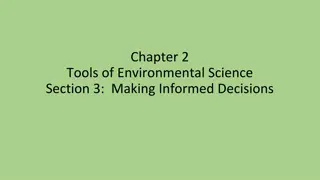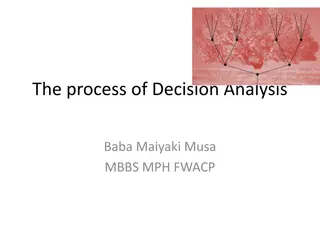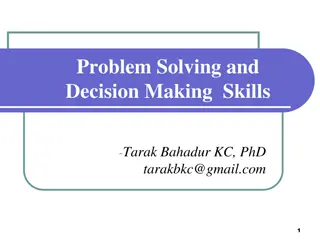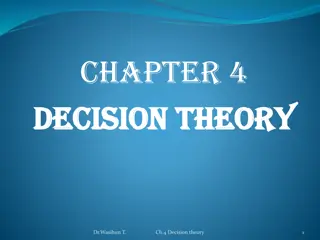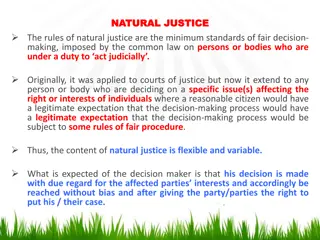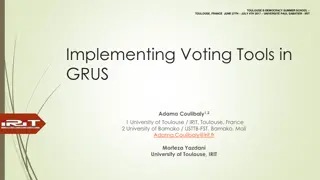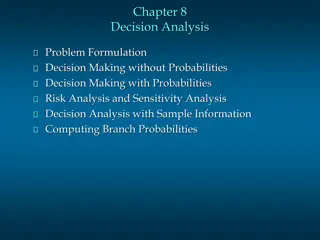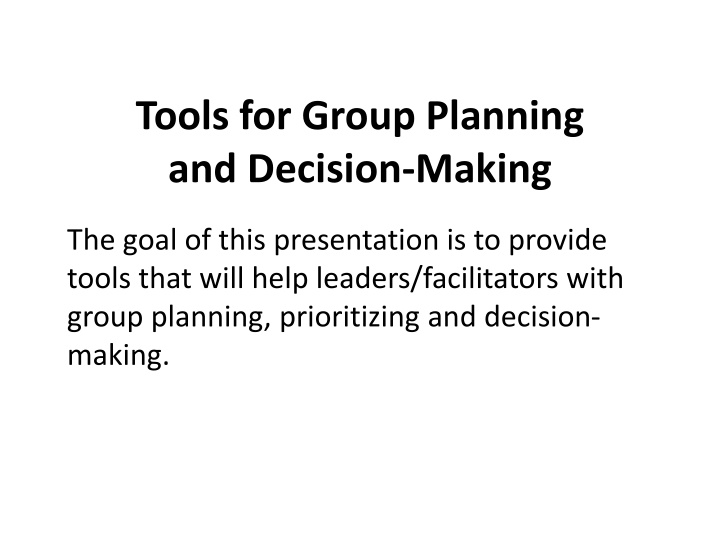
Tools for Effective Group Planning, Decision-Making & Facilitation
Explore valuable tools for group planning, prioritizing, decision-making, and facilitation. Learn about setting ground rules, utilizing the Nominal Group Technique, and fostering a conducive environment for collaborative activities within teams and committees.
Download Presentation

Please find below an Image/Link to download the presentation.
The content on the website is provided AS IS for your information and personal use only. It may not be sold, licensed, or shared on other websites without obtaining consent from the author. If you encounter any issues during the download, it is possible that the publisher has removed the file from their server.
You are allowed to download the files provided on this website for personal or commercial use, subject to the condition that they are used lawfully. All files are the property of their respective owners.
The content on the website is provided AS IS for your information and personal use only. It may not be sold, licensed, or shared on other websites without obtaining consent from the author.
E N D
Presentation Transcript
Tools for Group Planning and Decision-Making The goal of this presentation is to provide tools that will help leaders/facilitators with group planning, prioritizing and decision- making.
Exercise 1: Setting the Ground Rules University of Wisconsin-Madison (Facilitator Toolkit) (http://oqi.wisc.edu/resourcelibrary/uploads/resources/Facilitator%20Tool%20Kit.pdf Purpose: Set ground rules to keep the meeting focused and to promote a respectful climate
Instructions 1. Begin by telling folks that you want to set up some ground rules for the steering committee meetings. 2. Provide a list (on a flip chart) of ground rules for the committee to review. Ask the steering committee to say what rules they want to keep or remove. 3. Ask if the committee has other suggestions that will help the group do its work. Write this list on a flip chart and label ground rules. 4. Have a discussion to make sure everyone present agrees with the ground rules. If there are many corrections, rewrite. Preserve this page to bring back to all steering committee meetings.
Suggestions for Ground Rules Start and stop on time Listen to learn Seek first to understand Speak your own truth Encourage full participation Agree to disagree (respectfully) It s OK to put matters of race, ethnicity and class on the table Questions may be asked to clarify ideas Discussions are about understanding, they are not about being right or swaying others
Once you have created a set of ground rules, save the flip chart and display those ground at every meeting. If you are dealing with a conflictive group or if new participants join the group, it can be helpful to review the rules at the start of the meeting.
Exercise 2: Nominal Group Technique Iowa State Cooperative Extension (http://www.extension.iastate.edu/communities/decision) Purpose: The Nominal Group Technique (NGT) is a ranking method that allows groups to prioritize a large number of issues, especially those that are emotional or controversial.
This tool is useful in neutralizing potential domination by some group members. Although the end result may not be everyone's first choice, the NGT does achieve a consensus that participants can generally accept.
Instructions (Part 1) Write the issue on a flip chart Have individuals write down their possible solutions on a piece of paper Ask each team member to offer one solution, and record it on the flip chart Continue until all ideas have been listed Clarify the meaning of any statements Combine similar ideas
Instructions (Part 2) Assign a letter to each solution Have participants independently rank the ideas from most to least important Collate and total rankings on the flip chart Rewrite the list based on priority Confirm that participants can accept the final list
Exercise 3: Effort-Impact Grid University of Wisconsin-Madison (Facilitator Toolkit) (http://oqi.wisc.edu/resourcelibrary/uploads/resources/Facilitator%20Tool%20Kit.pdf Purpose: designed to evaluate possible solutions to an issue. This tool is useful for assessing the costs and benefits of various options. effective when there is limited time available option evaluation. The Effort-Impact Grid is It is particularly
Instructions Start by creating a numbered list of all the potential actions. Then, taking one action at a time, ask the group to quickly indicate how much effort they think it will take to accomplish that action and how much impact it will have on the overall goal. EFFORT/ IMPACT EASY DIFFICULT LOW impact or benefit 1 3 HIGH impact or benefit 2 4
Ideas placed in Quadrant 1 are easy but produce minimal benefit. They are appropriate when they can be included in annual plans or address existing problems. Ideas placed in Quadrant 2 are easy and produce significant benefit. They are easy to implement quickly. Ideas placed in Quadrant 3 are difficult and produce minimal benefit. Ideas from this quadrant should generally be discarded. Ideas placed in Quadrant 4 are difficult but will result in significant benefit. If these ideas are considered, appropriate time and resources should be made available for their exploration.
Exercise 4: Charette Procedure Iowa State Cooperative Extension (http://www.extension.iastate.edu/communities/decision) Purpose: The Charette Procedure is an idea generation and prioritizing tool designed for larger groups. Lasting four to seven days, this collaborative planning process consists of a series of meetings, design sessions, public workshops and open houses.
The Charette tool is useful when a group knows what it wants to achieve but is unsure of how to accomplish it. Benefits include: simultaneous resolution of multiple issues, active group participation, shared leadership opportunities, idea building and community engagement.
Instructions The following description is a condensed version of the full Charette Procedure, which normally occurs over a period of several days. Begin by dividing the larger group into several small groups of five to seven people. Provide each group with a discussion topic, and have them select a person to record ideas on a flipchart. Establish a time limit for gathering suggestions.
After the time limit has expired, move the recorderand flipchart to the next group. The recorder provides clarification of listed ideas to the new group and captures additional suggestions. Repeat the process until all groups have discussed all issues. In the final round, have the groups prioritize the most important ideas on their sheet. Reconvene the larger group. Display and summarize the prioritized topic results. Provide the larger group an opportunity to discuss the small group reports, review priorities, and reach consensus.
Exercise 5: Dotmocracy University of Wisconsin-Madison (Facilitator Toolkit) (http://oqi.wisc.edu/resourcelibrary/uploads/resources/Facilitator%20Tool%20Kit.pdf Purpose: Dotmocracy is a prioritization tool that allows groups to quickly see which proposals or ideas are the most popular by allowing participants to vote with 'dot' stickers. This exercise creates a fun activity, good visual, and limits discussion if it has gone on too long, as well as getting input from the entire group.
Instructions Begin by brainstorming all the options and list on a flipchart in any order. Leave enough space between the items to place sticky dots. Give each person in the group 10 dots (for this exercise, color is irrelevant). Instruct them that to indicate their priorities, they are to use all 10 dots but no more than 4 on any ONE item. Therefore, 4 dots would indicate their top priority. Some items will have no dots.
Participants walk up to the flipcharts and place their dots under the items. If you have a larger group, split the items on 2 flipcharts on opposite sides of the room so as not to take too much time or cause congestion. Start half the group on each chart. When everyone has placed his/her dots, count the number of dots for each item and make a priority listing on a new flipchart page. There usually are a few clear winners. You may then discuss with the group if they agree those should be top priorities on which to start working. It does not mean the others are eliminated.
Exercise 6: Progressive Question Purpose: Good for reviewing reports or written materials
Instructions Provide a copy of the draft Baseline Report for each person. You can make edits directly to the document in real-time if you use a computer and LCD projector. Inform the group they will explore answers to three questions as a way of getting feedback.
Questions: (Get agreement from the group on each change before moving on.) 1. Clarification Is there anything you didn t understand or that needs further clarification? 2. Reaction How do you feel about this report? Is it accurate? Comprehensive? Clear? 3. Action What needs to be added, removed or changed?
Action Steps Identify one or more volunteers to make the changes and prepare a final document. The final document should receive one final review before. This could be by the project leaders or the entire group.


